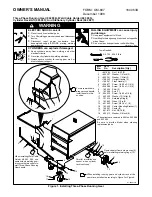
17
CUT QUALITY
The plasma process cuts by melting the material
and therefore a characteristic feature is the
greater degree of melting towards the top of the
metal resulting in poor edge squareness, top edge
rounding or a bevel on the cut edge. Cut quality
can often depend on setup and your application
parameters with torch height, cutting speeds
compressed air pressures along with the user
abilities to maintain these during the cutting
process.
To help understand cut quality, it is best that the
characteristics of the finished cut are looked at in
close detail, the image adjacent will help explain
this.
Cutting or torch angle
Generally when cutting with a plasma torch, the torch should be held perpendicular to the piece being
cut.
Stand off distance
The distance between the torch tip and the work piece during the cutting process will have an effect on
the bevel angles. The greater the distance, the greater the bevel angle will be. Typically, smaller hand
cutting systems (40 amps and under) are designed to drag the tip on the plate. For higher amperage hand
cutting systems, use of a drag shield cup, a standoff guide or a cutting guide will help keep a consistent tip
to work distance for best results.
Kerf width
While plasma cutting a void is left behind which is called the kerf in the material being cut.
Bevel angle
In an ideal cut, the bevel angle or angle of the cut surface would be perfectly square. The plasma cutting
process does result in a slight angle which is called a bevel angle, on both the cut and scrap side of the
work piece. This is why direction of cut is important. When the plasma gas flows, it has a swirling action as
it leaves the cutting tip’s orifice. This swirl is generally in a clockwise direction which results in one side of
the material being cut being squarer than the
other. This means it is very important to
consider the travel direction in relation to the
piece being cut. In the image adjacent, a circle
shaped object is being cut. The inside cut (A) is
done in the anti-clockwise direction and the
outside cut (B) is done in a clockwise direction.
So remember, if you are making a circular cut
and plan to keep the inside round piece as
your finished work, move in a clockwise
direction. If you plan to keep the piece from
which the circle was cut from then move in
an anti-clockwise direction.
















































